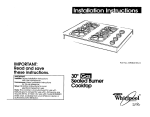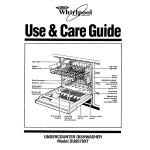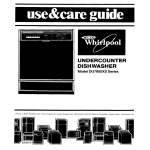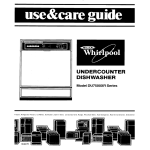Download Whirlpool GDP8700XT User's Manual
Transcript
PORTABLE DISHWASHER Model GDP8700XT Series \-q3 rs Ice Makers Dishwashers. BullI-In Ovens and Surlace Unlls. Ranges. Mwowave Ovens. Trash Compactors. Room Air Condillonen. Oehumldifiers. Aulomallc Washers. Clolhes Oryers, Freezers. R Contents Page Page BEFORE YOU USE YOUR DISHWASHER IMPORTANT SAFETY INSTRUCTIONS PARTS AND FEATURES POWER CLEAN* WASHING SYSTEM Quiet Operating Tips PROPERLOADING.................... Top Rack Loading Bottom Rack Loading Silverware Basket Loading ADDING DETERGENT RINSE AID DISPENSER BEFORE STARTING YOUR DISHWASHER STARTING YOUR DISHWASHER. Selecting a Cycle 01988 Whirlpool HI-TEMP Washing Option The AIR DRY Option The RESETOPTIONS Button Using DELAY START Changing a Setting The CLEAN Signal Light. To Add a Dish After Starting ENERGY SAVING TIPS SPECIAL TIPS COMMON DISHWASHING PROBLEMS., CONNECTING YOUR PORTABLE DISHWASHER IF YOU NEED SERVICE OR ASSISTANCE WHIRLPOOL DISHWASHER WARRANTY Corporation 9 9 9 10 10 10 10 11 12 13 15 16 20 ‘TMK Before you use your dishwasher It is your personal responsibility and obligation to be sure your dishwasher: Is installed by a qualified installer. l Has been installed where it is protected from the elements. l Has been installed on a floor strong enough to support its weight. l Has been properly connected to electricity, water and drain.* l Has been properly electrically grounded.* l Has had all hang tags and temporary labels removed. l Is not used by children or anyone unable to operate it properly. l Is properly maintained. *See installation instructions for comolete information. l Parts and features Model GDP8700XT Series UPPER SPRAY ARM RACK BUMPER HOSE CONNECTOR BOTTOM RACK DETERGENT DISPENSERS MODEL AND SERIAL NUMBER PLATE SILVERWARE BASKE RINSE AID DISPENSER LOWER SPRAY ARM \ THE OVERFLOW PROTECTOR is designed to prevent too much water from / entering the dishwasher It is not removable. HEATING ELEVENT ~ I DOOR COLOR PANEL ACCESS COLOR PANEL ‘THE POWER CLEAN* MODULE is designed to keep the wash and rinse water clean. It also grinds up and removes food particles. During grinding, some sounds will be heard. Tmk Thank you for buying a Whirlpool appliance. Please complete and mail the Owner Registration Card provided with this product. Then complete the form below. Have this information ready if you need service or call with a question, Model and Serial Numbers from [see diagram above] and the purchase from sales slip. . Keep this book and sales slip together handy place. l copy plate Model Number Serial Number date in a Purchase Service Date Company Phone Number 3 POWER CLEAN* Washing System Your dishwasher cleans by spraying a mixture of hot, clean water and detergent against soiled surfaces of dishes. When a cycle is started, the dishwasher fills with water to about the level of the heating element. This water is pumped through the rotating spray arms, through the POWER CLEAN* Module which removes food particles, and back through the rotating spray arms. Soiled water is pumped out and replaced with clean water during a cycle-the number of times depends on the cycle being used. The POWER CLEAN* Module removes food particles from the water, stores them, then washes them down the drain. Load dishes so soiled surfaces face erful spray from rotating arms. Step-saving preparation pow- for washing It Is not necessary to rinse dishes before pufflng them Into the dlshwasher. Just remove large pieces, bones, and other hard items. The POWER CLEAN* Module will remove food particles from the water. It contains a chopping device which will reduce the size of food items. If hard items such as fruit seeds, nuts and egg shells enter the POWER CLEAN* Module, you Hot water might hear chopping, grinding, crunching or buzzing sounds. Those sounds are normal when hard items enter the module. DO NOT LET METALLIC ITEMS (I.E. POT HANDLE SCREWS) GET INTO THE POWER CLEAN’ MODULE. THIS COULD RESULT IN DAMAGE TO THE POWER CLEAN’ MODULE. is a must Hot water dissolves and activates the dishwashing detergent. Hot water dissolves grease on dishes and helps dry glasses spot-free. Make certain loads are washed in hot water (at least 140°F - 60°C). Two ways to have a reliable hot water supply... I. Maintain 140°F water supply at central water heater. To check water temperature, turn on hot water faucet nearest the dishwasher. Let water run until it is as hot as possible, then check with a candy or meat thermometer. If the temperature is too low, have a qualified person raise the water heater thermostat setting. 2. Use HI-TEMP WASHING Option. If water heating is needed, a thermostat will delay the Cycle until temperature reaches 145°F (63°C). If water is hot enough, the cycle will proceed with no delay. This lets you turn down your water heater, if you choose, without cutting back on hot water needed for good dishwashing. Quiet operating tips To avoid thumping and clattering noises during operation: l Make sure lightweight load itemsare secured in the rack. l Make sure pot lids and handles, pizza pans, cookie sheets, etc. do not touch interior walls 4 l or interfere with either of the spray arms rotation. Load dishes so they don’t touch one another. ‘Tmk. Proper loading Always load dishes so soiled surfaces are reached by spray from rotating Water must be able to drain off completely for best drying results. Be careful items so spray can reach all surfaces. spray arms. to separate Top rack loading I CUP AND GLASS LOAD The top rack is designed for cups, glasses and smaller items. l Place so open ends face down for cleaning and draining. l load glasses in top rack only. Bottom rack is not designed for glasses. Damage may occur l l l Load plastic items in the top rack only. Only plastic items marked “dishwasher safe” are recommended. Plastic items can be melted in the bottom rack. Items with cooked-on soiled surfaces facing or dried-on the spray foods Place items in the rows between prongs. Placing them over the prongs can lead to breakage. Be sure lightweight items are held firmly in place l l China, crystal and other delicate items must not touch each other during dishwasher operation. Damage may occur. l l Small bowls, pans and other utensils can be placed in the top rack. should be loaded in the bottom rack with 5 Bottom I rack loading Silverware basket loading Load forks and spoons so they don’t nest together. Spray can’t reach nested items. NO Make sure pot handles and other items do not stop rotation of eitherthe upper or lower spray arm. Spray arms must move freely. . Load items so they do not block or cover the spray tower. l Securely place heavily soiled cookware face down in rack. l YES Mix items in each section of the basket. Small items-baby bottle caps, jar lids, etc.-can be put in any section. Make sure sharp items [knives, forks, skewers, etc.) are put in point down. The silverware basket can be loaded while it’s in place on the door, or it can be taken out for loading on the counter or table. It can also be removed for easy unloading. Always unload or remove the basket before unloading the racks to avoid spilling water droplets on the l Place plates, soup bowls, etc., between prongs and facing the spray. To remove the basket, slide it toward the top of the door - by the handle. Lift it off the holding buttons. Replace it in reverse order. l Load cookie sheets, cake pans and other large items at sides or back. Loading such items in front may keep water spray from reaching detergent dispenser and silverware basket. NOTE: Do not load glasses, cups or plastic items in the bottom rack. l When lower rack is removed, replace with bumpers in front. 6 l To open the basket, as shown. Be sure the cover is complete1 latched before pulling out the bottom rack and before closing the dishwasher door. unhook the latch Adding detergent The kind and amount of dishwasher detergent you use is an important getting your dishes clean. Read this section carefully. Use automatic washer detergent dishonly. ‘) The detergent Other detergents are too mild and much too sudsy to work in the dishwasher. Different brands of dishwasher detergent have different amounts of phosphorus. Phosphorus softens water and helps prevent water spots on dishes. - If water is hard and phosphorus content is low (6.0% or less), you may need to use more detergent or use a brand with a higher phosphorus content (8.7% or higher]. How much dispenser The detergent dispenser has one section with a cover and one without. l Put detergent in both sections for cycles with two washes. l Put detergent in the covered SeCtiOn only for cycles with one wash. l Push the cover down \ until it is latched. The cover opens automatically when the main ‘-7 11 wash starts, Detergent in the open section falls into the dishwasher r!!zia when the door is closed. F COVER LATCH COVER Do not add detergent until you are ready to wash. Fresh automatic dishwasher detergent is necessary for best washing results. Store detergent tightly closed in a cool dry place. part of J Use coveied section for.. NORMAL WASH Cycle LOW ENERGY WASH Cycle detergent 1’ Use both sections for.. POTS & PANS Cycle HEAVY WASH Cycle to use The amount of detergent to use depends on the hardness of your water. If too little is used, dishes won’t be clean. However, if too much is used in soft water, glassware will begintoetch. Find out your water’s hardness by asking your local water department, water softener company or county extension agent. l HARD - Fill 1 or both sections to top 8 or more grains of middle l 1 or both sections to line if water is 5 to 7 grains of SOFT - Fill 1 or both sections to bottom line if water is 0 to 4 grains hardness. of Rinse aid dispenser A rinse aid helps keep water from forming droplets and drying as spots. Keep the dispenser filled with a rinse aid such as Jet-Dry” A small amount is released automatically during the final rinse of each cycle. Check the dispenser periodically to see if it needs refilling. Keep the dispenser fill cap tightly closed. Before starting your dishwasher OPTION SELECTOR BUTTONS , 1. Read “Important Safety Instructions” on page 2 before starting your dishwasher. 2. Spin the Upper and Lower Spray Arms to make sure nothing will stop them from turning freely. 3. Push door firmly when closing and itwill automatically latch. 4. Run hot water, at sink where dishwasher will be connected, until it is hot. Turn off water. See page 15 for connecting instructions. Starting your dishwasher CYCLE SE&OR ~~~~~~ POTS & PANS cycle... HEAVY WASH cycle... 1. Push POTS & PANS Cycle Selector Button. 2. Push button(s) for option(s) desired. 3. Turn Cycle Control Knob clockwise to dot marked POTS & PANS. - POTS & PANS and HEAVY WASH Cycles share the same spot on the dial. The Cycle Selector Button determines which cycle operates. The dishwasher will automatically start that cycle. 1. Push HEAVY WASH Cycle Selector Button. 2. Push button(s) for option(s) desired. 3. Turn Cycle Control Knob clockwise to dot marked HEAVY WASH. - HEAVY WASH and POTS & PANS Cycles share the same spot on the dial. The Cycle Selector Button determines which cycle operates. The dishwasher will automatically start that cycle. NORMAL WASH cycle... LOW ENERGY WASH cycle... 1. Push NORMAL WASH Cycle Selector Button. 2. Push button(s) for option(s) desired. 3. Turn Cycle Control Knob clockwise to dot marked NORMAL WASH. The dishwasher will automatically start that cycle. 1. Push LOW ENERGY WASH Cycle Selector Button. 2. Push button(s) for option(s) desired. 3. Turn Cycle Control Knob clockwise to dot marked LOW ENERGY WASH. The dishwasher will automatically start that cycle. RINSE & HOLD cycle... 1. Push NORMAL WASH Cycle Selector Button, 2. Select AIR DRY Option only. 3. Turn Cycle Control Knob clockwise to dot marked RINSE St HOLD. The dishwasher will automatically start that cycle. Selecting a cycle POTS & PANS Cycle Maximum cleaning for cookedor baked-on foods. Timer delays while the dishwasher automatically heats the water to 145°F (63°C) in both washes and the last rinse (marked ‘1. Cycle time will be about 1% to 2 hours, depending on time needed to heat water. I CYCLE CONTROL KNOB HEAVY WASH Cycle A double wash for heavily soiled loads. Cycle time is about 76 minutes. NORMAL WASH Cycle For normal, everyday soiled loads. (The Energy Guide Label data is based on this Cycle.) Cycle time is about 68 minutes. LOW ENERGY WASH Cycle For pre-rinsed or lightly soiled loads, Cycle time is about 60 minutes. RINSE & HOLD For rinsing a few items to be washed one or more days later. Cycle time is about 14 minutes. Use AIR DRY only. Do not use HI-TEMP WASHING Ootion. HI-TEMP WASHING Option When this option is selected, water for the main wash and the final rinse is heated to145” F (63” C). Washing and rinsing action in those parts of the cycle will be longer if the water is heated. HI-TEMP washing is automatic in POTS & PANS. The AIR DRY Option Air in the dishwasher is automatically heated during the “dry” part of all cycles. If the AIR DRY Optlon is selected, air in the dishwasher is not heated. Using this option helps save energy, but dishes take longerto dry (over- The RESET OPTIONS night) and some water spotting may result. Some items (such as plastics] may need towel drying. For best results, use a liquid rinse aid such as Jet-Dry? Button If you want to change a selected option, push the RESET OPTIONS Button. Re-select an option, if desired. 9 Using DELAY START 4. Close and latch the door. 1. Push desired Cycle Selector Button. 2. Push desired Option Selector Button(s). 3. Turn Control Knob clockwise to the number of hours (from 1 to 4 hours) you want the dishwasher to delay before the selected cycle starts. NOTES: You can add items while time is counting down. Close and latch the door. The timer will not advance if the door is unlatched. l RINSE & HOLD and LOW ENERGY WASH Cycles cannot be delayed. l Changing a setting You can change a setting anytime during any cycle. 1. Lift up on the door latch to stop the cycle. Don’t open the door until the spray arms stop spinning. 2. Turn the Cycle Control Knob clockwise to the cycle you want. 3. Be sure the detergent dispensers are filled properly for the new cycle. 4. Press door firmly to latch it. The dishwasher will automatically start the new cycle. The CLEAN Signal Light The CLEAN Signal Light will come washing cycle is complete. on when a To add a dish after starting 1. To be sure the added item is washed and rinsed, make sure the Cycle Control Knob has not passed LOW ENERGY WASH. 2. Lift up on the door latch to stop the cycle. Don’t open the door until the spray arm stops spinning. 10 To turn light off, turn the Control Knob clockwise slightly until the light goes off. 3. Open the door and add the dish. 4. Close the door. Do not latch it. Wait 30 seconds for air in the dishwasher to warm up. This helps reduce the amount of moisture that can come from the vent when restarting the cycle. 5. Press door firmly to latch it. The dishwasher will start from where it stopped. Energy saving tips You can help save energy if you: 1. Wash full loads. Running a half-filled dishwasher uses the same amount of electricity and hot water as a fully loaded machine. 3. Air dry dishes drying cycle. (overnight). when you don’t need a rapid Allow longer drying times 2. Use the LOW ENERGY WASH Cycle whenever possible. It uses less hot water and energy than otherwash cycles. load correctly for best washing results. Incorrect loading may cause poor washing and the need to rewash all or part of the load. Don’t pre-rinse normally soiled dishes. Select the correct cycle for the load and use the recommended amount of detergent for good washing results without hand rinsing. Use your dlshwasher during off-peak hours. Local utilities recommend this to ovoid heavy usage of energy at certain times of day Kitchen cleanup can be done quickly and efficiently through the use of your dishwasher. Most appliance parts that can fit in the dishwasher can be cleaned by it. Burned-on soil, however, should be cleaned by hand. 11 Special tips on dishwasher use Remember, use your dishwasher only for the job it was designed to do. Some items are not dishwasher safe or may require special care. Read these special tips for the following items: &UUinUlU: Aluminum loses its bright, shiny appearance and darkens in color due to minerals the water and the alkalinity of the dishwasher detergent. Colored aluminum may fade. in TIPS: If washed in the dishwasher avoid placing directly in front of detergent dispenser where it could be sprinkled with undissolved detergent, causing spotting, pitting, and discoloration. Follow utensil manufacturers’ cleaning instructions. China: Hand-painted, metal-trimmed, and antique china fade due to high water temperatures and alkaline detergent solution in the dishwasher. NOTE: Delicate, antique items should not be washed in the dishwasher. TIPS: Load china carefully. Do not allow pieces to touch each other. Test one piece by washing it daily in the dishwasher for several weeks. Then compare it with the rest of the set to see if colors have changed. and decorative cQ&il temperature. dishwasher. @asses: Crystal can break from sudden exposure to high water Metal trim and colorful decoration on glass will fade in time when washed in the NOTE: Delicate, antique items should not be washed in the dishwasher. TIPS: Load crystal carefully in top rack only. Be sure to load a few larger items in the bottom rack to reduce amount of force of water spray reaching glassware from lower spray arm. Use the shortest cycle. Flatware: Salty and acidic foods may tarnish silver and stainless flatware if allowed to remain on the utensils. A film may form on sterling silver and silver plate items washed in a dishwasher. This film is caused by reaction of silver with chlorine in the detergent. Gold flatware is not dishwasher safe. TIPS: Rinse flatware as soon as possible, especially if it is not to be washed right away. Dishwasher detergent may remove antique finishes. Wash by hand.Tarnish and film build-up can be removed with silver polish. irOn Cast UteUSik The seasoned finish will be removed TIPS: Wash by hand. To re-season coat Plastics: sensitive Many plastics will have and may melt or warp. TIPS: If in doubt, protection. Non-stick try one piece. finish UteUSilS: TIPS: Follow manufacturers’ Wood: Many wooden Of pewter-like TIPS: To keep pewter “Dishwasher Place Safe” written in upper on them Rusting will result. Some plastics rack only. AIR DRY option Most can be washed boards, and warp wooden provides are heat additional in the dishwasher materials: or lose their finish salad bowls or knives May streak, discolor, Exterior - Regular use of a soft damp cloth or sponge and a mild detergent is all that is necessary, in most cases, to keep the outside of your dishwasher nice looking and clean. Interior - Hard water minerals may cause a white film to build-up on the inside surfaces, especially just beneath the door area. Wear rubber gloves when cleaning the dishwasher interior. Do not use any type of cleanser other than dlshwasher detergent because lt may cause foaming or sudsing. with wooden and pit. at its very best, hand wash with mild deteraent. Dishwasher care & cleaning: 12 in the dishwasher. fat and heat in a slow oven for an hour or two. suggestions items will crack TIPS: Do not wash cutting dishwasher. Pewter with unsalted handles in the Common dishwashing problems PROBLEM CAUSED BY SOLUTION Spottlng and fllmlng [hard water film] Hard water Fill detergent tergent with be necessary dispensers to capacity Use dishwasher highest available phosphorus content. to install water softener. deMay To I. 2. 3. remove spots and film, try o vinegar rinse... Wash and rinse load as usual. Use AIR DRY. Remove all metal items. Put 2 cups (500 ml] white vinegar in a container on the bottom rack. 4. Run dishwasher through a complete washing cycle. Water is not hot enough Not enough detergent, or improper detergent “0ld”detergent Improper loading No rinse aid AIR DRY Setting Small partlcles deposlted on Items used Spray arm or arms not rotating freely “Old” detergent not dry Chlpplng breaklng glassware or Make sure dishes and glassware are loaded so spray reaches all surfaces and items drain properly. Do not overload. Do not nest items Make sure large items do not block spray from reaching detergent dispensers. Does the rinse aid dispenser need filling? See instructions on page 7. Drying without heat may result in some spotting of glasses and silver. Check spray arms to make sure they turn freely after loading. Be sure a utensil has not prevented their turning. Use only fresh dishwasher detergent. Store tightly closed container, in cool, dry place. Discard old detergent. Do not fill dispensers until ready to start dishwasher. Water is not hot enough Water temperature should be at least 140°F (60°C). Set water heater thermostat to a higher setting. Run water at sink until hot before starting and/or use HI-TEMP WASH Option. If water pressure is low, do not use water for other purposes while dishwasher is running (to assure correct fills). Water is not hot enough with highwith hard Water temperature should be at least 140°F (6O”CJ. Set water heater thermostat to a higher setting. Run water at sink until hot before starting and/or use HI-TEMP WASH Option. Make sure dishes and glassware are loaded so spray reaches all surfaces and items drain properly. Do not overload. Do not nest items. loading No rinse aid AIR DRY Setting on closed Do not Use more dishwasher detergent. Use detergent est available phosphorus content...especially water. Improper Black marks dishes Use only fresh dishwasher detergent. Store tightly container, in cool, dry place. Discard old detergent. fill dispensers until ready to start dishwasher. Not enough detergent, or improper detergent Water pressure may be low, dishwasher is not filling properly Dlshes Water temperature should be at least 140°F (60°C). Set water heater thermostat to a higher setting. Run water at sink until hot before starting and/or use HI-TEMP WASH Option. Use more dishwasher detergent. Use detergent with highest available phosphorus content...especially with hard water. Fill rinse aid dispenser. used Allow more time when using AIR DRY Option, DRY. Plastic items may need towel drying. or use HEAT Aluminum utensils rubbing against items during washing Use care In loadlng alumlnum utensils, especially any llghtwelght toll container. Place so they do not touch dlshes. Remove black marks with plastic scouring pad and a mild abrasive cleanser Improper Do not overload. Load glasses in the top rack only. Load between prongs, not over them. Glasses loaded over prongs will not be supported and may chip or break. loading 13 PROBLEM CAUSED BY SOLUTION Dishes not washlng clean Water is not hot enough Water temperature should be at least 140°F (60°C). Set water heater thermostat to a higher setting. Run water at sink until hot before starting and/or use HI-TEMP WASH Option. Improper Make sure dishes and glassware are loaded so spray reaches all surfaces and items drain properly. Do not overload. Do not nest items. Make sure large items do not block spray from reaching detergent dispensers. loading Spray arm or arms not rotating freely Not enough detergent or improper detergent “0ld”detergent. Water pressure may be low, dishwasher is not filling properly 14 Cloudy tllm on glassware, etching permanent corrosion Too much detergent in soft water Dishes 6 lnterlor ot dlshwasher yellow or brown Iron or manganese water Rust spots on stalnless steel -ORDark spots on tlatware stalnlesr steel, sliver plate, or sterling Allowing salty or acidic foods such as mayonnaise, vinegar. fruit juices, salad dressings, milk products to remain on flatware. Undissolved detergent coming in contact with flatware Bronze tarnish on sllverplate Water lett in bottom ot dlshwasher Inadequate Check spray arms to make sure they turn freely after loading. Be sure a utensil has not prevented theirturning. Use more dishwasher detergent. Use detergent with highest available phosphorus content...especially with hard water. Use only fresh dishwasher detergent. Store tightly closed container, in cool, dry place. Discard old detergent. Do not fill dispensers until ready to start dishwasher. If water pressure is low, do not use water for other purposes while dishwasher is running [to assure correctfills). Check for rainbow hue on glasses. A rainbow hue is the first sign of etching [corrosion of glass]. Reduce the amount of dishwasher detergent. Use a detergent with a lower phosphorus content. If water pressure is low do not use water for other purposes while dishwasher is running [to assure correct water fills). Make sure dishes and glassware are loaded properly to assure adequate rinsing and draining. Do not overload. rinsing in Temporary remedy: I, Set empty dishwasher for a “one wash” cycle. 2. Start dishwasher and unlatch door to stop it when it has filled forthe wash part of the cycle. 3. Add % to % cup (120 to 240 mL) of citric acid crystals (usually available in drugstores). 4. Close and latch door to complete cycle. Permanent solution: Install an iron or manganese filter to home water supply. Rinse flatware that is to stand for several washing [use Rinse & Hold]. Clean stained polish and re-wash. Do not put stalnless tlatware In the same sllverware basket Direct contact between these metals can nent damage to the sliver. hours before items with silver steel and sliver compartment. cause perma- Remove spots with silver polish. Avoid spilling detergent on wet flatware. concentrated Silverplate is worn off. Exposed base metal takes on a bronzed hue. Remove replated Dishwasher completed Allow cycle not tarnish dishwasher with silver polish. to complete Have siiver cycle. your Dortable dishwasher Connectine A special adapter must be installed be connected. Complete instructions dishwasher. When moving your dishwasher, make sure the door is latched. Use the built-in pull bar or hold it at the top front corners. Before starting Run water at faucet until it is hot. Turn it off. Pull hoses out of their storage on the back. compartment ING COLLAR 3. 4. 5. 6. 7. HOSE CONNECTOR Pull down on the locking collar while lifting the hose connector onto the faucet adapter. When the connector snaps into place, release the locking collar. Turn the hot water on slowly until it is all the way on. Plug in power supply cord. See pages 8 and 9 to start the dishwasher. While dishwasher 6. Unplug storage power supply compartment. Electrical When cycle is finished Turn hot water off. [This can be done after the last rinse.] Press the red button on the connector to release the water pressure. Lift slightly on the hose connector while pulling down the locking collar. Pull down on the connector. Empty any remaining water from the connector. cord and return to Connection A power supply of 120 volts, 60Hz AC or 115 volts, 50Hz AC, 15 or 20 amps, is required. For your personal safety, this appliance must be grounded. This appliance is equipped with a power supply cord having a b-prong grounding plug. To minimize possible shock hazard it must be plugged into a mating 3-prong grounding type wall receptacle, grounded in accordance with the National Electrical Code and local codes and ordinances. If a mating wall receptacle is not available, it is the personal responsibility and obligation of the customer to have a properly grounded 3-prong wall receptacle installed by a qualified electrician. A WARNING: An extension cord should not be used with this appliance. Such use may result in a fire, electrical shock or other personal injury. I I is running You can draw water from the faucet while the dishwasher is connected. DO NOT draw water while the dishwasher is filling or while water is being pumped out. (This helps prevent a low fill when dishwasher is filling, or mixing drain water with fresh water.] 1. Press red button on hose connector to get the water you want. [The faucet is set on hot. Adjust faucet for the water you want.] 2. Be sure You return cold water to off, and that hot water is full on. Return hoses to storage on the faucet before the dishwasher can and the adapter are packed with your Power Supply Cord DO NOT, UNDER ANY CIRCUMSTANCES, REMOVE THE POWER SUPPLY CORD GROUND PRONG. Converting to built-in Your Whirlpool Portable Dishwasher can be converted to a built-in (undercounter] model by using conversion kit No. 569056. The kit is available at your Whirlpool dealer or authonzed TECH-CARE@ Service Company. Instructions are included with the kit. Caring for simulated wood top The simulated wood top can be used as a utility work surface for most kitchen jobs. It is stronger and more easily cleaned than genuine wood. The top can be used as a cutting board. Knife marks will be visible but will not seriously damage top. Hot items from the oven can be placed on the top. Clean with warm, soapy water. For dried on foods, use a scouring pad. compartment. 15 If you need service or assistance, we suggest you follow these six steps: 1. Before calling for assistance... 2. If you need assistance Performance problems often result from little things you can find and fix yourself without tools of any kind. If your dishwasher will not run, or stops during a cycle: l Is the door tightly closed and securely latched? l Has the cycle been correctly set? l Is the water turned on? l Have you checked your home’s main fuses or circuit breaker box? l Is the power supply cord plugged into a live circuit with the proper voltage? l If the motor has stopped because of an overload, it will automatically reset itself within a few minutes. If the motor does not start, call for service. If your dishwasher seems to run too long: l Are you using POTS & PANS Cycle or HI-TEMP WASHING Option? The dishwasher may be waiting for the water to heat, l Is your household water temperature set too low? Low water temperature settings will cause longer dishwasher operating times, If water remains in the dishwasher: l Has the cycle completed? l A small amount of remaining water is normal. If detergent remains ;n the covered detergent cup: l Is the bottom rack in backwards? [The rack bumpers should be at the front.) l Is the dishwasher detergent fresh? l Is the cycle completed? If you hear grinding, grating, crunching, buzzing sounds: l A hard object has probably entered the POWER CLEAN Module. The sound should stop when the object is ground up. 16 or service overseas... Contact distributor. your Military Exchange or Whirlpool WHEN YOU RETURN TO THE UNITED STATES Migratory Policy We realize that you’re purchasing a Whirlpool appliance forwhat may be a temporary stay in a particular area. If you are transferred to the United States and find that your Whirlpool appliance requires service within the warranty period, simply contact a Whirlpool authorized dealer or service agent All he’ll require is proof of the purchase date of the appliance. Service will be supplied as shown in your printed warranty. 3. If you need assistance in the U.S.-k... Call Whirlpool COOL-LINE” service assistance telephone number. Dial free from anywhere in the U.S.: 1-800-235-1301 and talk with one of our trained Consultants, The Consultant can instruct you in howto obtain satisfactory operation from your appliance or, if service is necessary, recommend a qualified service company in your area. 4. 5. If you have a problem in the U.S.?.. If you need service in the U.S.?.. Whirlpool has a nationwide network of franchised TECH-CARE” Service Companies. TECH-CARE service technicians are trained to fulfill the product warranty ( FRANCHISED SERVICE and provide afterwarranty service, anywhere in the United States. To locate TECHCARE service in your area, call our CCCL-LINE service assistance telephone number (see Step 3) or look in your telephone directory Yellow Pages under: APPLIANCES-HOUSEHOLOMAJOR-SERVICE&REPAIR ELECTRICAL APPLIANCES MAJOR-REPAIRING 8 PARTS WHIRLPOOL APPLIANCES FRANCHISEDTECH~CARESERVICE SERVICE XYZSERVICECO 123MAPLE OR WHIRLPOOL APPLIANCES FRANCHISEDTECH-CARESERVICE COMPANIES SERVI(‘E XYZSERVICECO 123MAPLE 999.9999 OR WASHING MACHINES, DRYERS h IRONERS-SERVICING WHIRLPOOL APPLIANCES FRANCHISEDTECH-CARESERVICE SERVICE XYZSERVICECO 123MAPLE COMPA.VIES COMPA~VIES 999.9999 Call our COOL-LINE service assistance telephone number (see Step 3) and talk with one of our Consultants, or if you prefer, write to: Mr. Donald Skinner Director of Customer Relations Whirlpool Corporation 2000 M-63 Benton Harbor, Ml 49022 6. If you need FSP ’ replacement parts in the U.S.?.. FSP is a registered trademark of Whirlpool Corporation for qualified parts. Look forthis symbol of quality whenever you need a replacement part for your Whirlpool appliance. FSP replacement parts will fit right and work right, because they are made to the same exacting specifications used to build every new Whirlpool appliance. * If you must call or write, please provide: model number, serial number, date of purchase, and a complete description of the problem. This information is needed in order to better respond to your request for assistance. 999 9939 17 Notes POWER CLEAN* WASHING SYSTEM PARTS COVERED BY YOUR WARRANTY SPRAY ARM NOZZLE SPRAY ARM ‘TMK 19 WHIRLPOOLf DISHWASHER WARRANTY LENGTH OF WARRANTY WHIRLPOOL DWOO3 WILL PAY FOR FULL ONE-YEAR WARRANTY From Date of Purchase FSP@replacement parts and repair labor to Correct defects in materials or workmanship. Service must be provided by a franchised TECH-CARE@ service company. LIMITED ONE-YEAR WARRANTY Second Year From Date of Purchase FSP replacement parts for any part of the POWER CLEAN’ Washing System if defective in materials or workmanship. These parts are shown on page 19 of this book. LIMITED NINE-YEAR WARRANTY Second Through Tenth Year From Date of Purchase FSP replacement of the porcelain should they fail to contain water workmanship. WHIRLPOOL tub and/or DURAPERM’ inner door due to defective materials or WILL NOT PAY FOR A. Service calls to: I. Correct the installation of the dishwasher. 2. Instruct you how to use the dishwasher. 3. Replace house fuses or correct house wiring or plumbing. B. Repairs when dishwasher is used in other than normal, single-family household use. C. Pick up and delivery. This product is designed to be repaired in the home. D. Damage to dishwasher caused by accident, misuse, fire, flood, acts of God or use of products approved by Whirlpool. E. Any labor costs during limited warranties. not WHIRLPOOL CORPORATION SHALL NOT BE LIABLE FOR INCIDENTAL OR CONSEQUENTIAL DAMAGES. Some states do not allow the exclusion or limitation of incidental or consequential damages so this limitation or exclusion may not apply to you. This warranty gives you specific legal rights, and you may also have other rights which vary from state to state. Outside the United States, a different warranty may apply. For details, please contact your franchised Whirlpool distributor or military exchange. ‘Tmk. Pm No. 3367699 Rev. A Ql988 Whirlpool Corporation Whirlpool L




















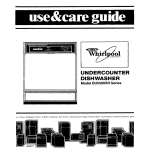
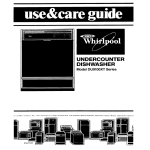

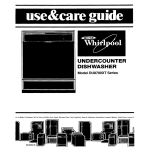
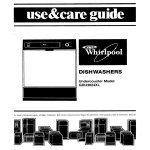
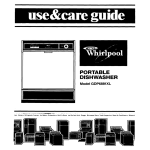
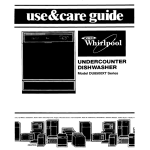
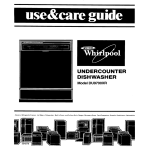
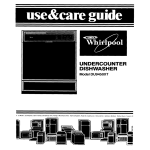

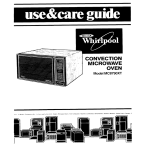
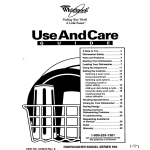
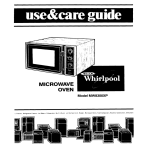

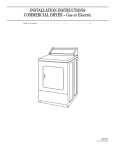

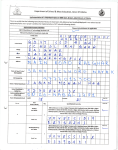
![j:j_"Xt$l"j:]:":,lg]:"r/Human Resources have been duty - e](http://vs1.manualzilla.com/store/data/005657435_1-26d97049bf04f0fd92265d73e45a9ab3-150x150.png)
